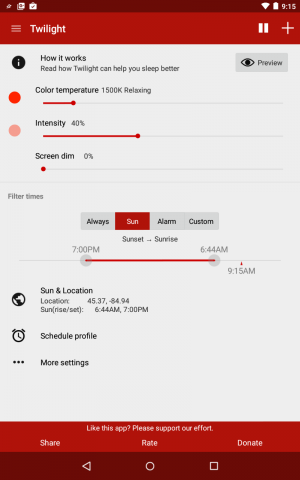Seeing Red and Getting Sleep

I'm always leery when I hear, Recent studies show.... But the idea that looking at electronic device screens before bed can cause sleep issues seems to be fairly accepted. The fascinating part for me is that it isn't really the screen itself, but the blue part of the color spectrum that contributes to the sleeplessness. In a purely anecdotal experiment, I find that it's much more difficult for me to fall asleep in the kitchen (cool-colored lighting, closer to blue in the spectrum) than it is to fall asleep on the living-room couch (warmer, less blue lights). Granted, part of that might be general comfort on the couch and more sharp objects in the kitchen, but in general, warmer lighting tends to be more relaxing.
Based on the idea that less blue and more red will make for better sleeping, the Twilight app for Android shifts the color of your screen as bedtime approaches. It's free for basic functionality, but for a small price, you can get a timed, gradual transition on your Android devices.


I have no idea whether it helps me sleep better, but if nothing else, it reminds me that it's getting late as my ebook becomes redder and redder as I read. If you struggle with sleeplessness especially when you first go to bed, give Twilight a try. It's free in the Google Play Store, and if it works, the gradual shift option with the paid version is well worth the cost. And as a bonus, the red screen won't hinder your night vision during those late evenings of summer stargazing!










